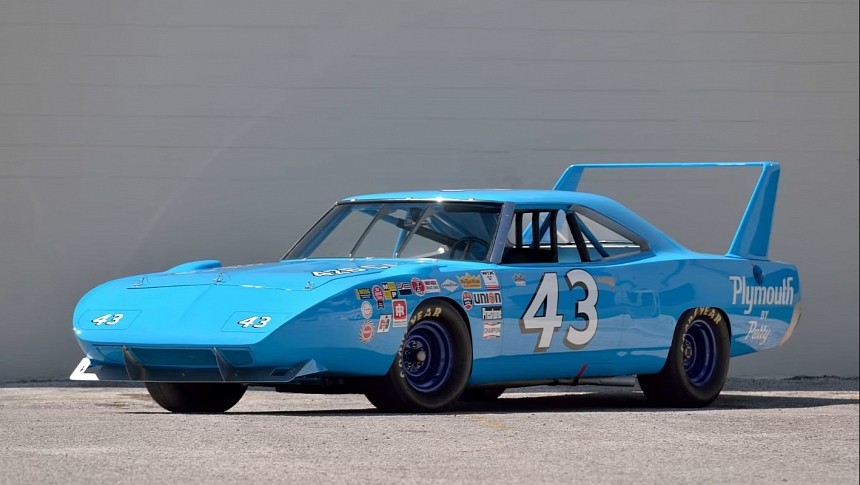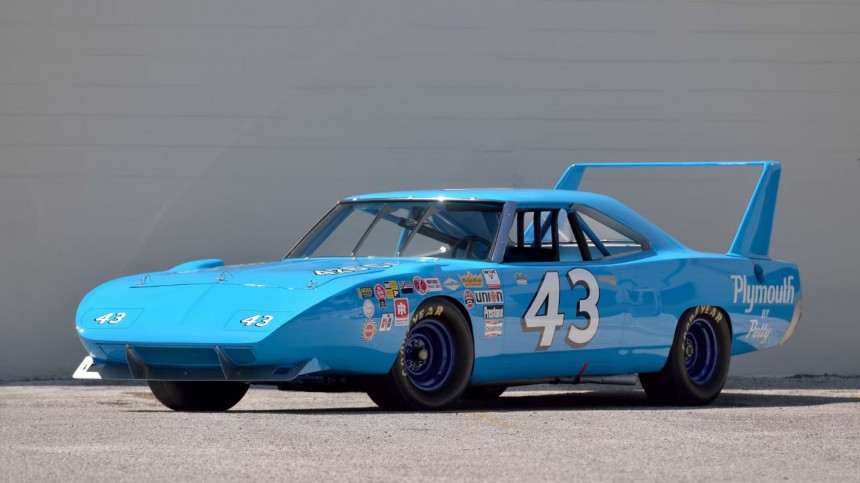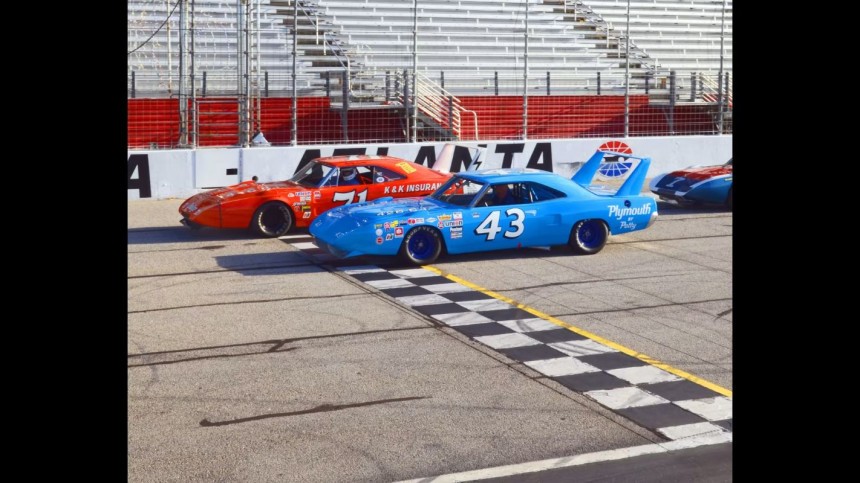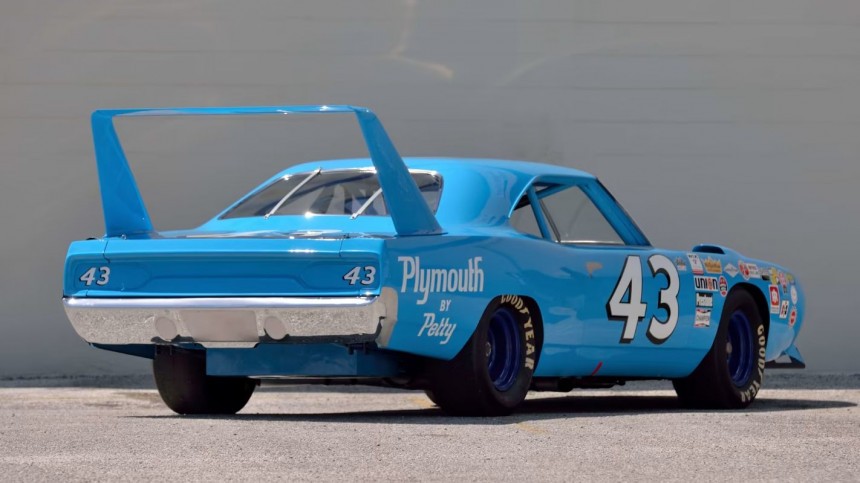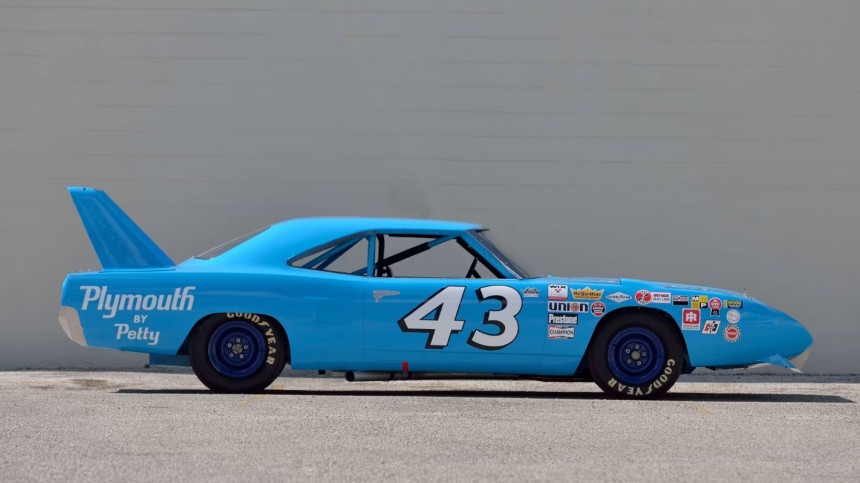In the realm of automotive rarities, the Plymouth Superbird stands as a formidable creature. Its existence spanned a mere single production year, gracing dealerships solely to lend credibility to its NASCAR counterpart.
Like a sibling born of different mothers, the Dodge Charger Daytona shared its fate, swiftly gaining notoriety in its inaugural racing season. Confronted with these awe-inspiring machines boasting sloping noses and colossal wings, NASCAR made an unexpected move by banning them from their tracks. Astonishingly, NASCAR justified its decision with a straightforward argument, claiming that the superior aerodynamics rendered them excessively swift.
While many assume the Dodge Daytona and Plymouth Superbird were akin, they were actually distinct entities. Notably, the Plymouth Superbird boasts an extraordinary genesis, one that shines a spotlight on none other than Richard Petty. And as for the astonishing velocity of the Plymouth Superbird, it traces back to the brilliance of a legitimate rocket scientist who once toiled at NASA before venturing into the realm of NASCAR. Prepare to delve into the captivating tale of the Plymouth Superbird and uncover why it surpassed the speed limits imposed by NASCAR.
Richard Petty, a name synonymous with NASCAR royalty, resides in the hearts of racing enthusiasts worldwide. Considered one of the greatest drivers in motorsport history, Petty's legacy is adorned with an unending tapestry of "firsts" and "mosts." Initially associated with Oldsmobile, Petty's unyielding allegiance to Plymouth spanned a decade, commencing in 1958.
However, the year 1968 ushered in a significant development when Chrysler unveiled the Dodge Daytona, an audacious incarnation of the revered Dodge Charger explicitly tailored for the racetrack. Yet, when Petty turned to Plymouth for a new racing companion, they, perplexingly, deemed the Belvedere unworthy of alteration.
This verdict came as a bitter blow to Petty, who had astonished the racing world in 1967 by securing a staggering 27 victories. The subsequent year, 1968, saw him claim a mere 16 triumphs, leaving him disheartened. Deprived of a new racing chariot by Plymouth, Petty redirected his loyalties towards the Ford Torino Cobra in a move fueled by disillusionment. Sensing the urgency to reclaim their prodigal champion, Plymouth embarked on a quest to craft a formidable track monster for NASCAR.
An influential figure from Plymouth's hierarchy approached Petty, genuinely inquiring about the price of his return. As the tale goes, Petty responded with a persistent request, demanding the squad to build him a Plymouth akin to the Dodge teams. And so, the wheels were set in motion, quite literally, as Plymouth commenced the arduous journey of metamorphosing Petty's aspiration into reality.
In a captivating twist of fate, Plymouth enlisted the expertise of Gary Romberg, a bona fide rocket scientist who had once been an integral part of NASA's illustrious space program during the 1960s. Romberg's background boasted a tenure with Boeing as a flight test engineer and a pivotal role in shaping the Saturn B-1 booster rocket, instilling an innate drive for velocity within him.
To recreate the awe-inspiring essence of the Dodge Daytona, Romberg and his team embarked on intense experimentation. They playfully toyed with the venerable Belvedere model, a faithful companion to Petty's racing endeavors, infusing it with a stubborn shark nose and an audaciously massive wing reminiscent of its Dodge counterpart.
Alas, despite their unwavering efforts within the confines of the wind tunnel, the Belvedere failed to measure up to expectations. Undeterred, Romberg pivoted his attention towards the Plymouth Road Runner, honing his aerodynamic modifications on its sleek frame. Astonishingly, everything fell seamlessly into place, prompting them to christen this newly minted, NASCAR-ready marvel as the Superbird, a playful nod to the beloved "Looney Tunes" character from Walt Disney's imaginative universe. With bated breath, they unveiled their creation to Petty, and their relentless endeavors bore fruit—come the following year, Petty triumphantly returned to the racing circuit in a Superbird.
Although often intertwined due to their shared attributes of a shark nose and an imposing rear wing, the Dodge Daytona and the Plymouth Superbird were, in truth, starkly different machines. The Daytona epitomized a modified incarnation of the mighty Dodge Charger, exuding unbridled power. On the other hand, the Plymouth Superbird cunningly concealed its aero-heavy soul beneath the guise of a Road Runner, engineered exclusively for the unforgiving battlegrounds of NASCAR.
When the Plymouth Superbird made its entrance, NASCAR's regulations stipulated that every participating car must have 500 street-legal counterparts sold to the public for qualification. However, as time unfolded, NASCAR altered its rules, demanding manufacturers to produce one showroom model for every two dealers within their network.
Adhering to these revised guidelines, Plymouth crafted a staggering 1,920 road iterations of the Superbird, ensuring its eligibility for NASCAR's fiercely competitive realm. The Superbird's unmatched combination of streamlined design and remarkable horsepower lured Petty back to Plymouth's embrace.
Throughout the 1970 NASCAR season, Petty notched eight victories while commanding the Superbird, consistently finishing among the top ten in numerous other races. Alongside Petty's triumphs, the Superbird amassed an additional ten wins courtesy of other skilled drivers, culminating in an impressive tally of 18 triumphant moments for the iconic vehicle in the 1970 NASCAR season.
Regrettably, the Superbird's existence was limited to the 1970 season, as fate would have it. The following year, NASCAR introduced fresh regulations that presented formidable obstacles for aerodynamic marvels like the Plymouth to thrive on the racetrack. Under these revised guidelines, vehicles were constrained to employ an engine no larger than 305 cubic inches or opt for a bulkier engine, thereby increasing the weight substantially compared to their competitors.
Given the substantial power-to-weight disadvantage inflicted by these regulations, Plymouth made the difficult decision to bid farewell to the Superbird for the 1971 season. Regrettably, the car's absence would persist as NASCAR continued to introduce new rules governing the realm of racing vehicles. These measures were primarily aimed at decelerating the speed of the cars to enhance safety.
During that era, the pace of vehicle development outpaced the advancements in tire technology, necessitating NASCAR's quest for means to temper the velocity. The sport sought to curtail the prevalence of cars wherein horsepower exceeded handling capabilities, ultimately leading to hazardous races and increased accidents. Additionally, soaring insurance rates and emerging emissions regulations within the automotive industry posed challenges for future iterations of the Superbird's design, making it increasingly impractical for the consumer market.
Although the implementation of these new rules was arguably indispensable in upholding safety standards for NASCAR racing, they ultimately marked the demise of the Superbird's brief existence. Despite its fleeting tenure, the vehicle's remarkable victories and the incomparable Richard Petty behind the wheel solidified its indelible status in the annals of NASCAR history.
In the link below is a ten-minute video posted on YouTube by the Goodwood Road & Racing of Richard Petty's 200 mph Plymouth Superbird going on the street roads.
While many assume the Dodge Daytona and Plymouth Superbird were akin, they were actually distinct entities. Notably, the Plymouth Superbird boasts an extraordinary genesis, one that shines a spotlight on none other than Richard Petty. And as for the astonishing velocity of the Plymouth Superbird, it traces back to the brilliance of a legitimate rocket scientist who once toiled at NASA before venturing into the realm of NASCAR. Prepare to delve into the captivating tale of the Plymouth Superbird and uncover why it surpassed the speed limits imposed by NASCAR.
Richard Petty, a name synonymous with NASCAR royalty, resides in the hearts of racing enthusiasts worldwide. Considered one of the greatest drivers in motorsport history, Petty's legacy is adorned with an unending tapestry of "firsts" and "mosts." Initially associated with Oldsmobile, Petty's unyielding allegiance to Plymouth spanned a decade, commencing in 1958.
However, the year 1968 ushered in a significant development when Chrysler unveiled the Dodge Daytona, an audacious incarnation of the revered Dodge Charger explicitly tailored for the racetrack. Yet, when Petty turned to Plymouth for a new racing companion, they, perplexingly, deemed the Belvedere unworthy of alteration.
This verdict came as a bitter blow to Petty, who had astonished the racing world in 1967 by securing a staggering 27 victories. The subsequent year, 1968, saw him claim a mere 16 triumphs, leaving him disheartened. Deprived of a new racing chariot by Plymouth, Petty redirected his loyalties towards the Ford Torino Cobra in a move fueled by disillusionment. Sensing the urgency to reclaim their prodigal champion, Plymouth embarked on a quest to craft a formidable track monster for NASCAR.
In a captivating twist of fate, Plymouth enlisted the expertise of Gary Romberg, a bona fide rocket scientist who had once been an integral part of NASA's illustrious space program during the 1960s. Romberg's background boasted a tenure with Boeing as a flight test engineer and a pivotal role in shaping the Saturn B-1 booster rocket, instilling an innate drive for velocity within him.
To recreate the awe-inspiring essence of the Dodge Daytona, Romberg and his team embarked on intense experimentation. They playfully toyed with the venerable Belvedere model, a faithful companion to Petty's racing endeavors, infusing it with a stubborn shark nose and an audaciously massive wing reminiscent of its Dodge counterpart.
Alas, despite their unwavering efforts within the confines of the wind tunnel, the Belvedere failed to measure up to expectations. Undeterred, Romberg pivoted his attention towards the Plymouth Road Runner, honing his aerodynamic modifications on its sleek frame. Astonishingly, everything fell seamlessly into place, prompting them to christen this newly minted, NASCAR-ready marvel as the Superbird, a playful nod to the beloved "Looney Tunes" character from Walt Disney's imaginative universe. With bated breath, they unveiled their creation to Petty, and their relentless endeavors bore fruit—come the following year, Petty triumphantly returned to the racing circuit in a Superbird.
When the Plymouth Superbird made its entrance, NASCAR's regulations stipulated that every participating car must have 500 street-legal counterparts sold to the public for qualification. However, as time unfolded, NASCAR altered its rules, demanding manufacturers to produce one showroom model for every two dealers within their network.
Adhering to these revised guidelines, Plymouth crafted a staggering 1,920 road iterations of the Superbird, ensuring its eligibility for NASCAR's fiercely competitive realm. The Superbird's unmatched combination of streamlined design and remarkable horsepower lured Petty back to Plymouth's embrace.
Throughout the 1970 NASCAR season, Petty notched eight victories while commanding the Superbird, consistently finishing among the top ten in numerous other races. Alongside Petty's triumphs, the Superbird amassed an additional ten wins courtesy of other skilled drivers, culminating in an impressive tally of 18 triumphant moments for the iconic vehicle in the 1970 NASCAR season.
Given the substantial power-to-weight disadvantage inflicted by these regulations, Plymouth made the difficult decision to bid farewell to the Superbird for the 1971 season. Regrettably, the car's absence would persist as NASCAR continued to introduce new rules governing the realm of racing vehicles. These measures were primarily aimed at decelerating the speed of the cars to enhance safety.
During that era, the pace of vehicle development outpaced the advancements in tire technology, necessitating NASCAR's quest for means to temper the velocity. The sport sought to curtail the prevalence of cars wherein horsepower exceeded handling capabilities, ultimately leading to hazardous races and increased accidents. Additionally, soaring insurance rates and emerging emissions regulations within the automotive industry posed challenges for future iterations of the Superbird's design, making it increasingly impractical for the consumer market.
Although the implementation of these new rules was arguably indispensable in upholding safety standards for NASCAR racing, they ultimately marked the demise of the Superbird's brief existence. Despite its fleeting tenure, the vehicle's remarkable victories and the incomparable Richard Petty behind the wheel solidified its indelible status in the annals of NASCAR history.
